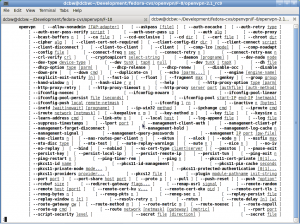Vincent, which specific options do you need that aren’t supported yet? If there are commonly used options that aren’t supported, then we should definitely figure out how to add them, but add them smartly. The large problem is that openvpn’s dev team is absolutely spineless and apparently adds every option anyone ever requests without thinking about how they fit into the larger picture. The larger picture is already huge:

That coupled with the fact that openvpn apparently has no capability to negotiate options with the peer means you have to specify the config exactly as the admin has set it on the server. This is a great recipe for Just Doesn’t Work. People have suggested that we add a GtkEntry or GtkTreeView that you can set to whatever you want, but given that openvpn gets run as root, we still need to validate those options. So why not figure out how to add them in a clear, consistent manner that’s marginally understandable to users?
All that said, there’s a number of options that we do need to add more support for, like HTTP proxy, DHCP over TAP interfaces, etc. Simply adding every single option is a great recipe incomprehensible interaction, so we need to get reports from users about what options are actually used in the wild. Please let us know!
